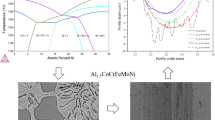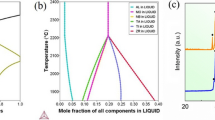Abstract
The diffusion bonding of Ti–6Al–4V alloy with different surface roughness was performed at 5 and 10 MPa. The influence of surface roughness on the void shrinking process and mechanisms was investigated. The average void size increases as the R a increases from 0.33 to 0.44 μm, while it decreases as the R a increases to 0.46 μm because of the decreasing of R λq. The void shrinking mechanisms were analyzed by using the dynamic model of void shrinking. Power-law creep is a dominant mechanism on void shrinking, of which the contribution decreases as the R a increases from 0.33 to 0.44 μm, while it increases as the R a increases to 0.46 μm. The influence of surface roughness on the contribution of plastic deformation and surface source mechanism on void shrinking is not significant while that on the contribution of interface source mechanism is dependent on the imposing pressure. The optimizing surface roughness is with a R a of 0.33 μm and R λq of 5.38 μm in this study.









Similar content being viewed by others
References
L.D. Hefti, J. Miner. Metals Mater. Soc. 62, 42 (2010)
Y.W. Xun, M.J. Tan, J. Mater. Process Technol. 99, 80–85 (2000)
A. Bahramian, Appl. Surf. Sci. 311, 508 (2014)
M.F. Islam, J. Pilling, N. Ridley, Mater. Sci. Technol. 13, 1045 (1997)
H. Somekawa, K. Higashi, Mater. Trans. 44, 1640 (2003)
G.G. Zhang, R.S. Chandel, J. Mater. Sci. 40, 1793 (2005)
A.R. Wang, O. Ohashi, K. Ueno, Mater. Trans. 47, 179 (2006)
X. Shao, X.L. Guo, Y.F. Han, W.J. Lu, J.N. Qin, D. Zhang, Mater. Des. 65, 1001 (2014)
A.S. Zuruzi, H. Li, G. Dong, Mater. Sci. Eng. A 270, 244 (1999)
B. Derby, E.R. Wallach, Metal Sci. 18, 427 (1984)
A. Hill, E.R. Wallach, Acta Metall. 37, 2425 (1989)
H. Chen, Y. Zhong, W. Hu, G. Gottstein, Mater. Sci. Eng. A 452–453, 625 (2007)
H.Y. Chen, J. Cao, J.K. Liu, X.G. Song, J.C. Feng, Comput. Mater. Sci. 71, 179 (2013)
R.F. Ma, M.Q. Li, H. Li, W.X. Yu, Sci. China Technol. Sci. 55, 2420 (2012)
Acknowledgments
The authors gratefully appreciate the financial support from the National Natural Science Foundation of China (51505386 and 51275416), the China Postdoctoral Science Foundation (2014M562447) and the Research Fund of the State Key Laboratory of Solidification Processing (NWPU), China (BP201503).
Author information
Authors and Affiliations
Corresponding author
Rights and permissions
About this article
Cite this article
Li, H., Li, M.Q. & Kang, P.J. Void shrinking process and mechanisms of the diffusion bonded Ti–6Al–4V alloy with different surface roughness. Appl. Phys. A 122, 18 (2016). https://doi.org/10.1007/s00339-015-9546-9
Received:
Accepted:
Published:
DOI: https://doi.org/10.1007/s00339-015-9546-9




